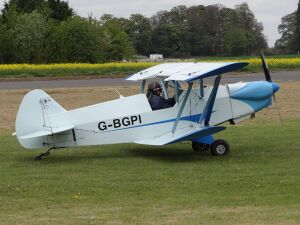Engineering:Plumb BGP-1
From HandWiki
Short description: British homebuilt aircraft
| Plumb BGP-1 Biplane | |
|---|---|

| |
| Prototype leaving Turweston Aerodrome in April 2017 | |
| Role | Homebuilt aircraft |
| National origin | United Kingdom |
| Designer | Barry Plumb |
| First flight | 1986 |
| Number built | 2 |
The Plumb BGP-1 is a British single-seat homebuilt biplane developed by Barry Plumb.
Design and development
The aircraft is patterned after the Pitts Special and is made predominantly from wood. The first example of Plumb's biplane was built between 1975 and 1986 and is on a Popular Flying Association (now Light Aircraft Association) permit to fly.[1][2]
The aircraft was originally powered by a Volkswagen 1834 engine but now uses a Jabiru 2200A model[3]
A second example, was finished in 2015 and uses a Volkswagen 1834 engine.
Specifications (prototype)
Data from Steen Aero[2]
General characteristics
- Crew: 1
- Wingspan: 4.87 m (16 ft 0 in)
- Powerplant: 1 × Jabiru 2200A , 60 kW (80 hp)
Performance
- Cruise speed: 120 km/h (75 mph, 65 kn)
- Stall speed: 72 km/h (45 mph, 39 kn)
- Never exceed speed: 232 km/h (144 mph, 125 kn)
See also
- Similar aircraft
References
- ↑ "Aircraft Data G-BGPI, 1986 Plumb BGP-1 C/N PFA 083-10359" (in en). http://www.airport-data.com/aircraft/G-BGPI.html.
- ↑ 2.0 2.1 "Steen Aero Lab - Biplane Lore". http://www.steenaero.com/biplane_lore.cfm. Retrieved 10 April 2018.
- ↑ "LA Safety Spot June 2014". Light Aviation. http://www.lightaircraftassociation.co.uk/2014/Mag/June/safety%20spot%20June.pdf.
 |

